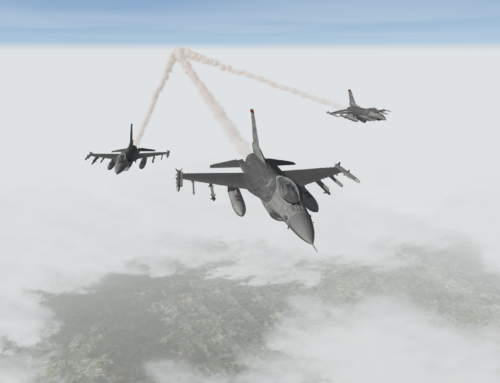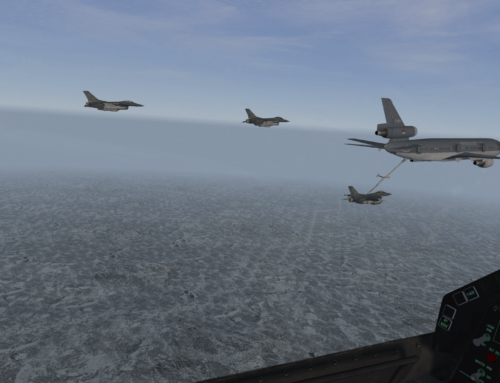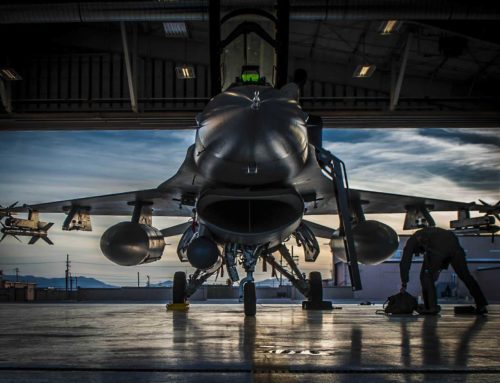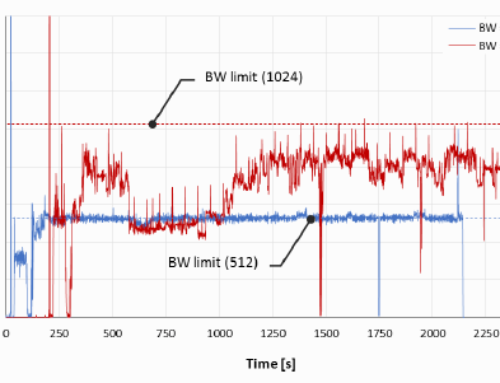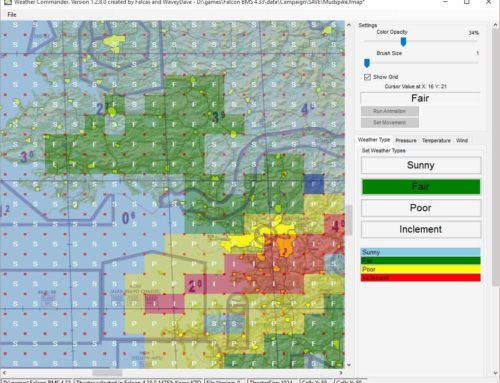The First Briefing

If you’ve read part 1, you should have avoided most of the technical pitfalls of starting Multiplayer. You should have done at least one MP connection and verified that you could hear someone else through IVC and that they could hear you. Read on, and discover how to participate in a Falcon BMS Multiplayer briefing.
Be Honest

Some groups, like the Falcon Lounge, host flights of all skill levels. Specifically at the Falcon Lounge, if a mission planner can fit you into his plan, he will. A human pilot is usually far better than an AI with few exceptions, even if that human pilot is new and inexperienced. When you express interest in joining a Multiplayer flight, and you’re asked about your skill level and what weapons you can employ, this often means they are trying to find a role suitable for you. When this happens, be honest. Don’t undersell or oversell; just tell the truth about what you can do, and say it concisely, accurately and confidently.
Missions have minimum requirements, or else they won’t work. For example, DEEP STRIKE missions may require the use of a tanker for air-to-air refueling. These requirements are usually determined by the Mission Planner or Package Lead. Sometimes it isn’t possible to find a role for your skillset in a particular mission. Don’t take it personally if you’re told you should sit a mission out. On the other hand, if you’re encouraged by the Package Lead to fly a mission that you aren’t confident in, you should consider taking the plunge. After all, he has a plan in mind, and he knows what he’s signing up for when he invites a newbie that hasn’t done Multiplayer before! Let him worry about the results.

Prerequisites of Skill
At the most basic level, you should already be able to do the following:
- Take off
- Navigate
- Fly formation with your lead1
- Employ some weapons
- Use TACAN
- Use the Data Link2
- Land
Some communities, like the Falcon Lounge, require you to Ramp Start — that is, starting a cold jet, configuring the systems, and preparing it for taxi. Other groups require Taxi Start, where the jet is started up for you. It’s up to you to know the rules of the community with whom you are flying. If they require Ramp Start, you should be able to start the jet consistently, including handling hot starts and other emergencies. The good news is that once you master Ramp Start, it doesn’t matter which procedure the community requires for commit, because you’re ready for it.
In terms of weapons knowledge, the following would be helpful to start off with:
- AMRAAMs
- AIM-9s
- Dumb bombs (ie. Mk-82s, Mk-84s) in CCRP
- Dumb bombs (ie. Mk-82s, Mk-84s) in CCIP
Knowing just the above is enough to get you a seat in most flights. Many bombs can be dropped using CCRP. For example, laser-guided bombs require you to learn how to use the laser, but what you learned about CCRP still applies. You can gain some valuable Multiplayer flight experience while continuing to learn.
Learn to be a Wingman
All pilots new to Multiplayer are typically expected to start off as wingmen. This is not necessarily because you need to earn your place as a lead (although some squadrons might indeed choose to operate that way), but rather because it’s easiest for everyone, including you, to start off in that role. Being a wingman in Multiplayer is different than being a lead in Singleplayer. Some would say it’s much easier, since it gives you a chance to focus on a limited portion of the mission without worrying about so many details of the overall war.

Terminology
We’ll use the following simplified terminology for now:
- Ship: a single aircraft
- Flight: a collection of ships, usually 2 or 4, united under a single callsign with a single task
- Package: a collection of flights, up to 5 in Falcon BMS, united with a single, mission goal
- Flight Lead: the leader of a flight; he takes the #1 slot, and #2 is his wingman.
- Element Lead: the leader of the 2nd element; he takes the #3 slot, and #4 is his wingman3
- Wingman: usually the #2 and #4 of a flight
When you find a Multiplayer mission that is suitable for you, join in either the #2 or #4 slot to start out. As a wingman, you’re expected to stay with your lead in formation until you’re told otherwise. If you’re #2, stick with #1. If you’re #4, stick with #3. For that matter, it is useful to know a bit about standard formations so you know where you should be located.
In Multiplayer, the leads worry about such things as coordination between flights, loadouts of the mission, threat assessments to the mission, and many other things. Instead of initially focusing on the big picture, wingmen should focus on the smaller picture: their own role in relation to their lead.

Pre-Briefing
Before you even attend your first Multiplayer briefing, there are some things to do first:
- Ensure your controls are working: Please test them if you have any doubts. You can start Falcon BMS, choose Instant Action, and give your controls a quick test. When you’re satisfied your controls are working, you should exit the flight and shut down Falcon BMS entirely.
- Ensure you know how to employ your assigned weapons: if you are scheduled to join a SEAD flight, you should probably know how to use HARMs. If you joined an ESCORT flight, you should probably be familiar with AMRAAMs and AIM-9s. You can run a quick mission in Singleplayer to brush up on anything you’ve forgotten. Never underestimate the worth of simply going over the relevant portions in the manual before a flight.
- Download any briefing aids: for example, if the Mission Planner has supplied you with an ini file containing STPT information, download and place this file in the Campaign directory of the theater you’re supposed to fly. If you don’t know where this is, ask someone connected with the mission.
- Set IVC “Outsiders” Option: If you’re flying with human GCI, you’ll be told to set outsiders=all. Consult the Falcon BMS manuals on how to do that, or ask someone connected with the mission for instructions.
- Close Falcon BMS and IVC completely: You’ll want Falcon BMS to be freshly opened before you join a server for any Multiplayer flight.
Briefing

Because of the dynamic nature of the campaign, you’re quite possibly going to face chaos once you get into the air. A proper briefing will help keep things under control.
Be punctual. If the briefing starts at 1800z, then try to show up 15 minutes before that. Some missions even have a marshal time specifically to get people to show up early and get situated. Falcon communities often use the Zulu time zone to coordinate. Know how to convert Zulu to your time zone. The briefing usually takes place over voice in a 3rd party program like Discord or Teamspeak.
When you get into the briefing, don’t speak at this point. In fact, this is the time for you to have a pen and paper handy so you can begin writing things down. Some newbies make the mistake of immediately asking questions pertaining to the mission and trying to get ahead of everyone else. These newbies, while well-meaning, are just making the briefing take longer.
Some events require you to be joined to the server and slotted into your seat prior to the briefing. If this is the case, then do this quickly. Sometimes certainly aspects of the briefing will rely on how many pilots have shown up, and it will help speed up the briefing to have everyone slotted correctly.
Package Briefing
For package missions, the briefing is conducted often by the Mission Commander (often called a Package Lead in Falcon communities), although it might be a Mission Planner who initiates the briefing and hands it over to the Package Lead. The Package Lead will often begin by explaining the overall package objective. He will then further explain how each flight will coordinate and assist each other, and how the Package is expected to return safely to base. The Package Lead may also explain the conditions for a package abort, such as losing too many ships in the TARCAP, or the SEAD flight running out of HARMs.
This is still not really the time for wingmen to ask questions. Instead, let the flight leads ask relevant questions first. The philosophy being employed here is that the entire package goal will be completed by the flights performing their tasks, which in turn will be accomplished by each pilot performing his assigned role. Don’t try to focus on more than you should handle. In fact, you’ll be flying off of your lead’s wing most of the time anyway, and this should be where much of your focus will go during the flight.

Flight Briefing
When the package briefing is over, or if your mission is composed of only one flight and there was no separate package briefing, you’ll do a flight briefing. The purpose of the flight briefing is to coordinate within the flight over details that aren’t relevant to the package. For example, a STRIKE flight may be tasked with striking a pair of bridges. It doesn’t matter to the package which bridge is targeted by which members of the STRIKE flight. The important thing at the package level is that the STRIKE flight is tasked to destroy both bridges. In the flight briefing, however, these details of which member(s) of the flight would be assigned to take out which bridge are exactly the kind of things to be briefed.
In addition to what you wrote down during the Package briefing, write down all the important information that the Flight Lead briefs. There are tools, such as Weapons Delivery Planner, that enable you to type up the information as required or import it from a mission file. You can then place this information on your kneeboards, so you can consult it when you’re in the cockpit. Whether you write it down physically or take it virtually with you in the cockpit, the important thing is that you will have this information in the cockpit.
Examples of pieces of information to write down:
- Your callsign within the flight (and the other callsigns as well)
- JOKER/BINGO
- TACAN
- The data link table
- Your VHF preset for intraflight communication
- Target STPT assignments
- Laser codes
If you are unfamiliar with concepts such as JOKER, BINGO, data link, and TACAN, then consult the BMS manuals as these are important concepts.
Lastly, when the flight lead opens the floor to questions, that’s when you should ask any questions that you have pertaining to your role within the flight. If the flight lead forgets to open the floor to questions and has ended the flight briefing, ask your questions quickly and concisely.
In the rare case that this is a scramble mission, you may not be able to have a proper briefing, in which case you may have to get your questions asked and answered while in the jet, but these kind of missions seem rare and are not usually newbie-friendly flights to begin with.
Common Mistakes
There are many common mistakes to be made as a newbie wingman during the briefing, and they should be avoided. Some helpful instructions of what NOT to do are as follows:
- Do NOT interrupt the briefing with questions.
- Do NOT ask questions that have already been answered.
- Do NOT answer for others, including for your own flight.
- Do NOT move the bullseye.
- Do NOT change any flight’s flight plan, including your own.
- Do NOT change any flight’s Loadouts, including your own.4
- Do NOT avoid asking good questions when it’s time.
Click Dance

The “click dance” is something unique to Falcon BMS. After you load into the 2D mission planning screen, whether it’s a Campaign or a Tactical Engagement, you’ll need to do the following:
- Select your flight in the ATO on the left.
- Clicking on the blue seat corresponding to your position in the flight.
- Open your data cartridge.
- Select the Comms tabs, and click on Comms Plan.
- Select the IFF tab, and select IFF Plan.
- Save your data cartridge.
If something changes in your flight, you may need to do this again. Do NOT skip any steps!
Some Falcon BMS pilots may do this multiple times before they commit to 3D, once as soon as they get into 2D in order to ensure the briefing page and comms ladder are correctly displayed, and then again right before they commit to 3D just in case they changed anything.
Note: If you don’t do this at least once, you all but guarantee seeing the wrong information on the briefing page, or having the wrong frequencies in your data cartridge. It is a waste of time to go through a whole briefing just to realize that you have the wrong comms plan loaded in your jet.
IVC Check
Some time during the briefing, an IVC Check will be executed. This is where everyone sounds off through IVC in order to make sure everyone can hear everyone else. This procedure is done orderly.
Different communities may do their IVC checks somewhat differently, but one method is to have the flight lead of the first flight in the package begin by saying his callsign over IVC. If he is heard, then the others in his flight will follow suit, each one saying his callsign starting with his #2, then his #3, and finally his #4, each proceeding after hearing the previous person. The second flight in the package will then do the same thing, and then the third until all flights have finished. If someone isn’t heard, he is skipped. When the check is completed, the ones who couldn’t hear or who couldn’t be heard try again after troubleshooting their issues.

Let’s say you perform the “click-dance” mentioned earlier, and you then click on Briefing. You’ll see the order of the flights in your package. Let’s say the callsigns of the flights are as follows:
- Falcon 1
- Hawkeye 2
- Viper 1
Let’s say you’re #4 in Hawkeye 2. You would wait for Falcon 1 to begin their IVC check first. The process may sound something like this:
- “Falcon 1-1 IVC.”
- “Falcon 1-2”
- “Falcon 1-3. No 4.”5
- “Hawkeye 2-1”
- “Hawkeye 2-2”
- “Hawkeye 2-3”
This is your cue. Make sure the BMS window is selected. (Click on the background map of the 2D mission planning screen to make sure.) Then press and hold F26, and say your callsign. In this example, it would be “Hawkeye 2-4.” If everyone heard you, then the IVC check would continue seamlessly with Viper 1-1.
If you didn’t hear anyone, or if they couldn’t hear you, then you have an issue. IVC may be using the wrong audio device, or it may have locked up. Some pilots forget to click on the BMS window before they press the transmit button, and the transmission is never sent to IVC. If you’re sure that the Falcon BMS window has focus, then you should begin troubleshooting the issue with IVC.
Now that you have completed your first Multiplayer briefing, you’re finally ready to start. Your jet awaits. The next article will explain the basics of actually flying.
1 This doesn’t have to be perfect, but if lead turns around, he should be able to see you roughly where he expects you.
2 You should be able to find where your lead and other flight members are with the data link.
3 If #1 is shot down or otherwise unable to lead, #3 is expected to take over control of the flight.
4 You can open the Loadout window, but beware! If you press “OK” in the Loadout window, you will overwrite any changes made in between the time you clicked Loadout and the time you clicked “OK.” Changes made by a flight lead will be overwritten, and this will result in some displeased pilots. Only leads should adjust loadouts!
5 In this example, there is no human in the #4 slot of Falcon 1. #3 in that flight is alerting the next flight of this with the phrase “no 4,” so they know that Falcon 1 flight has no human #4. The next flight should begin their IVC check.
6 F2 controls the VHF radio during the IVC check. F1 is often used, which is the UHF radio, but the Falcon BMS manual specifically recommends F2 for IVC checks to avoid them being broadcasted to 3D.

